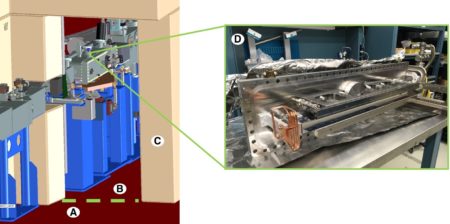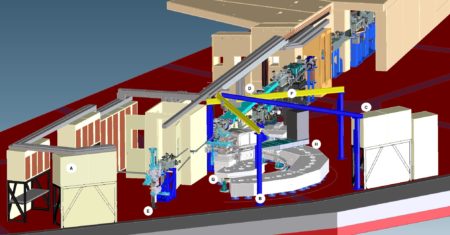By Cindy Lee
The footsteps of users and the hum of the accelerator can only mean one thing: the six-week summer shutdown at the ALS has ended, and beam time for users has resumed. Many smaller maintenance-related updates were completed, and preparation began for several major improvement projects. Below, you’ll find some recaps of the larger projects from the shutdown, particularly the many exciting developments in Sector 6. None of the changes will affect the delivery of light.
Much of the maintenance-focused work prepared the facility for a full storage ring alignment that will take place during the upcoming January shutdown. The ALS also significantly upgraded the HVAC system, which will improve overall user experience and experimental conditions. The large expanse of the experimental hall, including our iconic dome, poses challenges to thermal stability. Upgrades during this shutdown consolidated the multitude of temperature control zones, which should help maintain a set temperature of 72°F and overall thermal stability. In turn, fewer temperature fluctuations will affect the equipment in the facility.
A major project during last year’s shutdown prepared Sector 2 for the new protein crystallography beamline, Gemini. After this summer’s shutdown, Gemini is connected to the ring; the first aperture and valve are now installed. These steps have prepared the space for shield wall penetration, setting the stage for the next shutdown, when Leda, the in-vacuum insertion device will be added. Read more about this undulator or walk through the Building 15 high bay to say hello to Leda.
The program formerly located at Endstation 6.3.1.2 has now moved to Beamline 7.3.1, setting up for high-pressure in situ soft x-ray spectroscopy. The beamline will accept general user proposals for UHV XAS experiments of solid-state samples in the 2019-1 (January–July) cycle; in situ XAS experiments will be available at a later date.
A major rebuild of Sector 6, which will be home to two new soft x-ray programs, is well under way. The sector is chicaned, allowing two insertion devices and two beamlines in one straight. AMBER (6.0.1) will be used for x-ray absorption spectroscopy (XAS), x-ray emission spectroscopy (XES), and x-ray fluorescence spectroscopy (XFS). QERLIN (6.0.2) will be used for x-ray absorption spectroscopy (XAS), x-ray emission spectroscopy (XES), and resonant inelastic x-ray scattering (RIXS).

AMBER: 6.0.1 will be the Energy, Catalytic, and Chemical Science beamline. AMBER is reusing the insertion device from the previous beamline in this space. In addition, the team swapped out the original first mirror (M1) for the new AMBER M1. This is only possible during a shutdown because M1 is located inside the storage ring shielding.

QERLIN: 6.0.2 will be the Double-Dispersion RIXS beamline. The x-ray beam from the storage ring will be focused down to about 2 μm wide and 2 mm tall before exciting the sample. The narrowness of the beam will require a higher degree of stability than stainless steel platforms can provide. As part of the process to stabilize the beam in both the horizontal and vertical directions, the equipment will be attached to two large granite installations. In preparation for installing the granite, the paint has been stripped from the floor. The last mirror of QERLIN will be located on a granite island, and the detector will be on an arm that sweeps in a path stabilized on a granite arc. A new crane in Sector 6 will facilitate the installation of 21 tons of granite in total.
